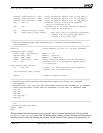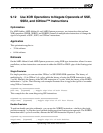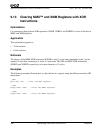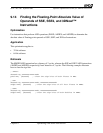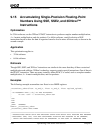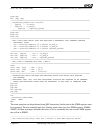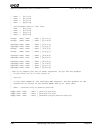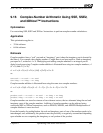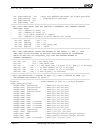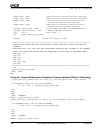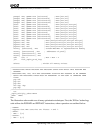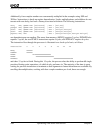
Chapter 9 Optimizing with SIMD Instructions 221
Software Optimization Guide for AMD64 Processors
25112 Rev. 3.06 September 2005
9.16 Complex-Number Arithmetic Using SSE, SSE2,
and 3DNow!™ Instructions
Optimization
Use vectorizing SSE, SSE2 and 3DNow! instructions to perform complex number calculations.
Application
This optimization applies to:
• 32-bit software
• 64-bit software
Rationale
Complex numbers have a “real” part and an “imaginary” part (where the imaginary part is denoted by
the letter i). For example, the complex number z1 might have a real part equal to 4 and an imaginary
part equal to 3, written as 4 + 3i. Multiplying and adding complex numbers is an integral part of
digital signal processing. Complex number addition is illustrated here using two complex numbers, z1
(4 + 3i) and z2 (5 + 2i):
z1 + z2 = (4 + 3i) + (5 + 2i) = [4+5] + [3+2]i = 9 + 5i
or:
sum.real = z1.real + z2.real
sum.imag = z1.imag + z2.imag
Complex number addition is illustrated here using the same two complex numbers:
z1 + z2 = (4 + 3i)(5 + 2i) = [4 × 5 - 3 × 2] + [3 × 5 + 4 × 2]i = 14 + 23i
or:
product.real = z1.real * z2.real - z1.imag * z2.imag
product.imag = z1.real * z2.imag + z1.imag * z2.real
Complex numbers are stored as streams of two-element vectors, the two elements being the real and
imaginary parts of the complex numbers. Addition of complex numbers can be achieved using
vectorizing SSE or 3DNow!instructions, such as PFADD, ADDPS, and ADDPD. Multiplication of
complex numbers is more involved.
From the formulas for multiplication, the real and imaginary parts of one of the numbers needs to be
interchanged, and, additionally, the products must be positively or negatively accumulated depending
upon whether we are computing the imaginary or real portion of the product.



